Sustainable and Scalable Enzymatic Production, Structural Elucidation, And Biological Evaluation of Novel Phlorizin Analogues
Résumé
It is not unusual for naturally occurring compounds to be limited for their use in cosmetics due to their low water solubility. Recently, aiming at accessing novel phlorizin (a glycosylated bioactive recovered from apple tree wood and already used in cosmetics as antioxidant ingredient) analogues, we reported the synthesis of very promising – but low water‐soluble – biomass‐derived chalcones (CHs) and dihydrochalcones (DHCs) exhibiting antioxidant and anti‐tyrosinase activities. Glycosylating bioactive compounds being one of the most common strategies to increase their water solubility, herein we report the enzymatic glycosylation of the CHs mentioned above, as well as DHC using cyclodextrin glycosyltransferases (CGTase), enzymes well‐known for catalyzing the selective α(1→4) transglycosylation. Indeed, while most natural glycosides are β‐glycosides (such as phlorizin), the selected enzyme produces selectively new α‐glycosides, thus expanding their structural diversity. A first step of separation using Centrifugal Partition Chromatography (CPC) led to mono‐, di‐ or triglycosides‐enriched fractions, which were then submitted to a comprehensive purification strategy for an in‐depth chemical profiling of the synthesized α‐glycosides, revealing that the major compounds were glycosylpyranosides. Surprisingly, among the diglycosides characterized, besides the expected maltoside compounds, nigeroside derivatives were also identified in significant amounts, depending on the starting compound structure. Finally, evaluating the antiradical, anti‐tyrosinase and antimicrobial activities of the major glycosides revealed them as potential sustainable alternatives to current petro‐sourced cosmetic ingredients.




